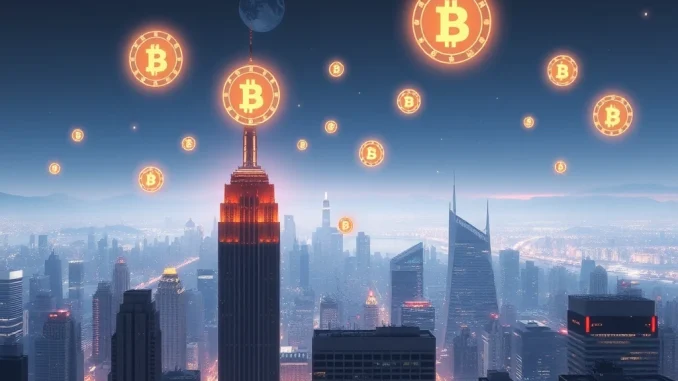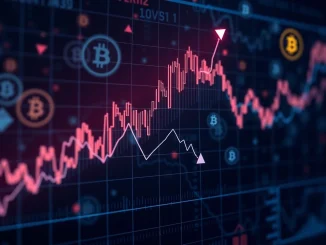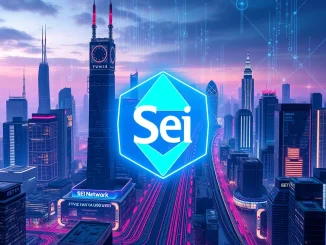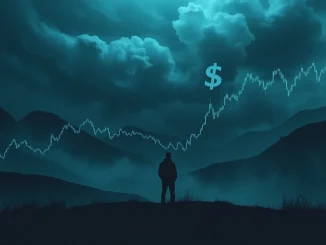
The world of cryptocurrency is constantly evolving, and one of the most exciting trends gaining momentum is Real World Asset (RWA) tokenization. Imagine turning real-world assets like real estate, art, or even company shares into digital tokens that can be traded on the blockchain. Sounds futuristic? Well, it’s happening now, and at an incredible pace! According to Jamie Coutts, Chief Crypto Analyst at Real Vision, the RWA tokenization market has experienced explosive growth, doubling in size to reach a staggering $19 billion in just one year. Let’s dive into the details of this fascinating market surge and explore what it means for the future of finance.
What is Real-World Asset (RWA) Tokenization and Why is it Exploding?
Before we delve deeper into the impressive growth figures, let’s understand what real-world asset tokenization actually entails. In simple terms, tokenization is the process of representing ownership rights of a real-world asset – anything from a physical object to a financial instrument – as a digital token on a blockchain. Think of it as creating a digital certificate of ownership that is secure, transparent, and easily transferable.
Why is this gaining so much traction now? Several factors are contributing to the crypto market growth in RWA tokenization:
- Increased Efficiency and Liquidity: Tokenization breaks down large, illiquid assets into smaller, more accessible fractions. This fractional ownership opens up investment opportunities to a wider range of investors and significantly enhances liquidity. Imagine investing in a fraction of a prime real estate property or a valuable artwork – tokenization makes this possible.
- Enhanced Transparency and Security: Blockchain technology, the backbone of tokenization, provides unparalleled transparency and security. All transactions are recorded on an immutable ledger, making ownership and transfer records easily verifiable and resistant to fraud.
- Reduced Costs and Intermediaries: Traditional asset management often involves numerous intermediaries, leading to higher costs and slower processes. Tokenization can streamline these processes by automating many tasks and reducing the need for intermediaries, ultimately lowering costs and increasing efficiency.
- New Investment Opportunities: Tokenized assets unlock a plethora of new investment opportunities that were previously inaccessible to the average investor. From private credit and real estate to commodities and intellectual property, a vast range of assets can now be brought onto the blockchain, creating a more diverse and inclusive investment landscape.
- Growing Institutional Interest: Major financial institutions and corporations are increasingly recognizing the potential of RWA tokenization. Their entry into the space is driving further legitimacy, investment, and innovation, contributing to the market’s rapid expansion.

Breaking Down the $19 Billion RWA Tokenization Market: Where is the Growth Happening?
Jamie Coutts’ analysis provides a fascinating breakdown of where this $19 billion market is concentrated. Let’s examine the key sectors experiencing the most significant growth in tokenized assets:
Private Credit Tokenization: A Major Driver
Private credit leads the charge in RWA tokenization, expanding by an impressive 1.7 times to reach $12 billion. Private credit, which involves lending to companies outside of traditional banking channels, is often characterized by illiquidity and limited access for individual investors. Tokenization is revolutionizing this sector by:
- Increasing Accessibility: Tokenizing private credit instruments makes them accessible to a broader investor base, including retail investors who were previously excluded from this market.
- Improving Liquidity: Tokenized private credit can be traded on decentralized exchanges (DEXs) and other platforms, significantly enhancing liquidity compared to traditional private credit investments.
- Enhancing Transparency: Blockchain-based tracking of private credit token ownership and transactions increases transparency and reduces counterparty risks.
US Treasuries and Stocks: Surging Sectors
While private credit dominates in terms of total value, the tokenization of U.S. Treasuries and stocks is experiencing even more dramatic growth rates.
- U.S. Treasuries Tokenization: This sector has surged by four times, reaching $4 billion. Tokenizing government bonds like U.S. Treasuries offers investors the benefits of blockchain efficiency and fractional ownership in traditionally safe and stable assets.
- Stocks Tokenization: The tokenization of stocks has witnessed an astounding 70-fold increase, reaching $450 million. While still a smaller segment compared to private credit and treasuries, this explosive growth indicates a significant interest in bringing equity ownership onto the blockchain. Stock tokenization can potentially democratize access to stock markets globally and streamline trading processes.
Here’s a table summarizing the growth:
| Asset Class | Growth Rate (Past Year) | Current Market Size |
|---|---|---|
| Private Credit | 1.7x | $12 Billion |
| U.S. Treasuries | 4x | $4 Billion |
| Stocks | 70x | $450 Million |
| Total RWA Tokenization Market | 2x | $19 Billion |
Ethereum’s Dominance in RWA Tokenization: Why Does it Matter?
Coutts highlights that a significant 75% of the $19 billion in tokenized assets are managed on Ethereum or its layer-2 blockchains. This dominance of Ethereum DeFi in the RWA tokenization space is noteworthy for several reasons:
- First-Mover Advantage: Ethereum was one of the first blockchains to support smart contracts, which are essential for tokenization. This first-mover advantage has allowed Ethereum to build a robust ecosystem of tools, infrastructure, and developer talent around tokenization.
- Established DeFi Ecosystem: Ethereum boasts the largest and most mature decentralized finance (DeFi) ecosystem. This existing infrastructure, including DEXs, lending platforms, and stablecoins, provides a fertile ground for RWA tokenization to flourish.
- Strong Community and Development: Ethereum has a vibrant and active developer community constantly innovating and improving the platform. This continuous development ensures that Ethereum remains at the forefront of blockchain technology and can adapt to the evolving needs of the RWA tokenization market.
- Network Effects: The more projects and assets are tokenized on Ethereum, the stronger the network effects become. Liquidity, composability, and interoperability within the Ethereum ecosystem attract more participants and further solidify its leading position.
The Future of RWA Tokenization: What to Expect?
The doubling of the RWA tokenization market to $19 billion in just one year is a powerful indicator of the transformative potential of this technology. As the market matures, we can expect to see:
- Continued Exponential Growth: With increasing institutional adoption, regulatory clarity, and technological advancements, the RWA tokenization market is poised for continued exponential growth in the coming years. Some analysts predict that this market could reach trillions of dollars in the next decade.
- Broader Asset Classes Tokenized: Beyond private credit, treasuries, and stocks, we can expect to see a wider range of asset classes tokenized, including real estate, commodities, intellectual property, art, and even carbon credits.
- Integration with Traditional Finance: The lines between traditional finance (TradFi) and decentralized finance (DeFi) are becoming increasingly blurred. RWA tokenization is a key driver of this convergence, bridging the gap between the old and new financial systems. We can expect to see more collaborations and integrations between TradFi institutions and DeFi platforms.
- Evolving Regulatory Landscape: As RWA tokenization gains prominence, regulators worldwide are paying closer attention. While regulatory uncertainty remains a challenge, increasing dialogue and the development of tailored regulatory frameworks will be crucial for fostering sustainable growth and innovation in this space.
Conclusion: Riding the Wave of RWA Tokenization
The explosive growth of the RWA tokenization market is not just a fleeting trend; it represents a fundamental shift in how we think about and interact with assets. By leveraging the power of blockchain technology, RWA tokenization is unlocking new levels of efficiency, liquidity, and accessibility in financial markets. As the market continues to mature and innovate, it promises to reshape the future of finance, creating a more inclusive, transparent, and efficient global financial system. Keep an eye on this space – the DeFi revolution fueled by real-world asset tokenization is just getting started!



